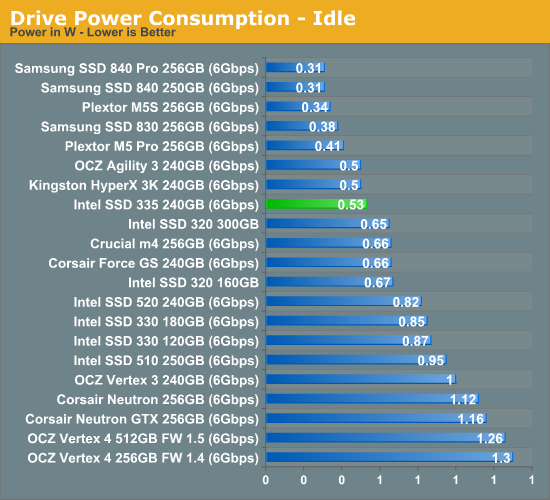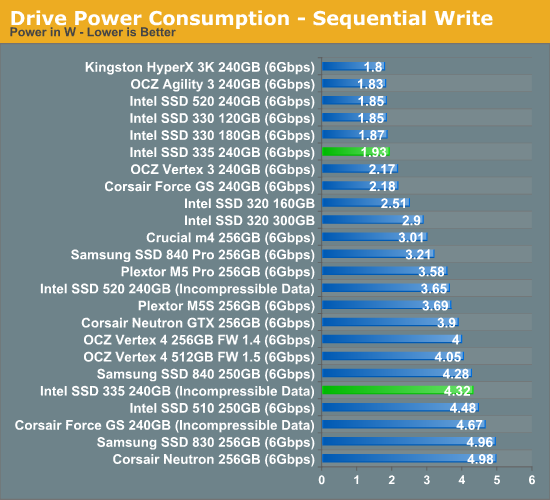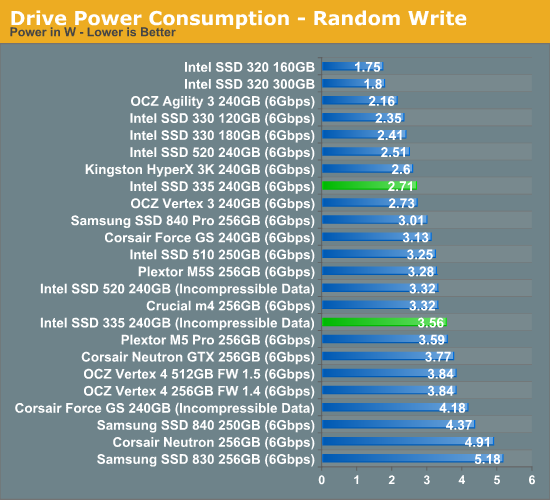Intel SSD 335 (240GB) Review
by Kristian Vättö on October 29, 2012 11:30 AM ESTPower Consumption
Idle power consumption has gone down thanks to smaller lithography NAND and possibly some firmware tweaks, but on the other hand load power consumption has gone up. The difference is fairly negligible with compressible data but the SSD 335 consumes a good 0.6W more than the 240GB SSD 520 when writing incompressible sequential data to it.













69 Comments
View All Comments
MichaelD - Tuesday, October 30, 2012 - link
I agree! Take Corsair for example; they've got like a hundred (sic) different SKU's. "Force" "Subforce" "Battle" "Skeedaddle" and "Primo" versions of SSDs...marketing FUD at it's finest. Only the .5% of SSD buyers (like AT readers) will actually look at specs and decide. The other 99.5% will just buy whatever box has the "fastest looking" cover art.zanon - Monday, October 29, 2012 - link
Now they just get giggle-stomped across the board by Samsung. I hope Intel decides to be competitive again someday, but in the mean time it's hard to see any reason to bother.MadMan007 - Monday, October 29, 2012 - link
Read past the sythetics to real-world tests. It is at least competitive in most cases, and all these drives are stupid fast anyway.jeffbui - Monday, October 29, 2012 - link
Why is there such a discrepancy between the power consumption figures given by the manufacturer vs what you're getting from your testing? (Samsung mostly) Other websites are getting completely different power usage figures as well.DanNeely - Monday, October 29, 2012 - link
Comments on one of AT's other recent SSD articles claimed this is because the power consumption test is being done using an external enclosure that never lets the drive drop into it's lowest power states. I didn't see any official comment on it.Kristian Vättö - Monday, October 29, 2012 - link
Some manufacturers such as Samsung report their power numbers with DIPM/HIPM (Device/Host Initiated Link Power Management) enabled, which can lower the power consumption significantly. DIPM/HIPM are not enabled on desktop by default and I'm not sure if all laptops have them enabled either.We have ran tests with DIPM/HIPM enabled and gotten results similar to what manufacturers report, but so far we have kept on publishing numbers with DIPM/HIPM disabled. We will probably add DIPM/HIPM numbers once we redo our SSD testing methodology.
DanNeely - Monday, October 29, 2012 - link
If available, would the feature be called DIPM/HIPM in our bios's; or is it likely to be obfuscated to something else?Also, why is it often disabled by default? Is there a penalty related to enabling it?
Kristian Vättö - Monday, October 29, 2012 - link
Here are instructions for enabling DIPM/HIPM:http://www.sevenforums.com/tutorials/177819-ahci-l...
In desktops it's not as important because you aren't running off of a battery and the power that SSDs/HDs use is so little anyway that it won't affect your power bill. I'm not sure why it's disabled, though, because I havent heard of any concrete issues caused by it.
Per Hansson - Monday, October 29, 2012 - link
Actually I'm not sure that DIPM/HIPM is the whole reason.I mentioned it previously and it for sure can have a dramatic difference.
But just as important is the measuring equipment used for the power consumption.
A cheap DMM only measures in very slow intervals, you would get very different results when measuring using a $100 Fluke vs a $1000 Fluke vs a Scope with really high bandwidth.
It's because the SSD changes power levels many hundred times per second and this is too fast for a regular DMM so you just get some of the data points, not enough to make a reliable averge...
MrSpadge - Monday, October 29, 2012 - link
Wouldn't the slower / cheaper DMM measure over longer intervals (that's why it's slow in the first place) and hence automatically average over some fluctuation?